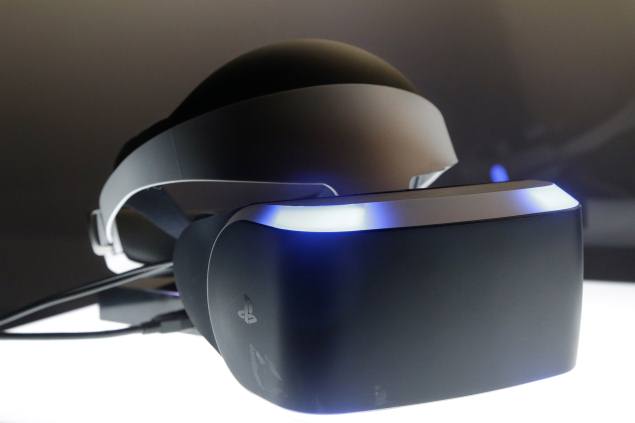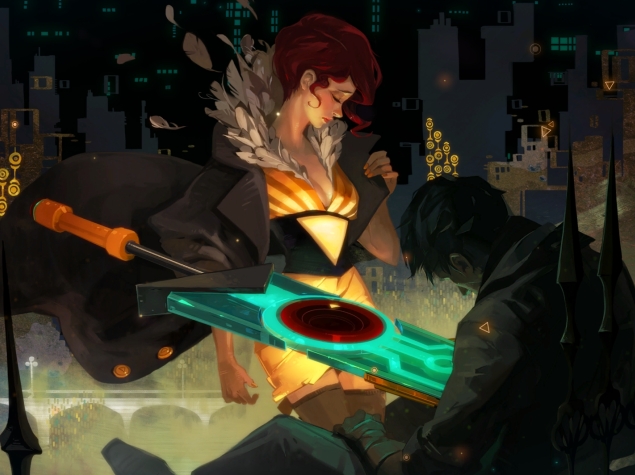Sony unveiled a prototype headset this week capable of surrounding a wearer’s vision with interactive virtual worlds. The system, codenamed Project Morpheus, utilizes a 1080p head-mounted display with head-tracking capabilities and works in concert with the PlayStation 4 console to display imagery on the headset’s screen, providing a 90-degree field of view.
During a private demonstration of Project Morpheus to The Associated Press at the Game Developers Conference, the headset felt secure thanks to a sturdy yet comfortable halo-like ring that snaps into place around the head. There’s a wheel positioned on the back headband that can be turned for an even tighter fit.
![]()
It’s lighter than one might expect and certainly sleeker than the Oculus Rift, a similar VR headset that’s captured game makers’ imaginations over the past two years but has yet to be released. A long, thick cable that pokes from the side of the visor, as well as dangling headphone cords, prove cumbersome during physical movement while wearing the goggles.
A closer look at four of the interactive experiences – not actual full-fledged games – Sony was using to demonstrate Project Morpheus at GDC:
“The Deep”: This demo created specifically for Project Morpheus by Sony’s London studio cast a standing user in the role of deep sea diver – complete with virtual wet suit and flare gun – inside a shark cage that submerges into the depths of the ocean. The undersea encounter is interrupted by a great white who attacks the enclosure at the first whiff of blood.
With lush graphics and stereoscopic 3D audio, “The Deep” showcased how Project Morpheus could recreate frantic “Jaws”-like moments as the shark ominously circled the cage. However, it wasn’t completely immersive because Project Morpheus only tracked movement of the head and DualShock 4 controller, so fin flipping wasn’t translated to the feet on screen.
“EVE: Valkyrie”: Developed by CCP Games and set in their “EVE” universe, “Valkyrie” is a sci-fi multiplayer dogfighter pitting players against each other in the cockpits of galactic fighter jets. Project Morpheus’ version featured richer graphics and details, like a massive carrier in the distance of the star field battleground, than the one demoed over at Oculus Rift’s booth.
Playing in a seated position with a DualShock 4 controller in hand that acts as the spaceship’s yoke, the sedentary orientation provided “Valkyrie” with a VR advantage. Pulling off dizzying maneuvers like rolls, spins and corkscrews while simultaneously blasting other users compellingly simulated what it might be like to really pilot an X-Wing from “Star Wars.”
Nasa Mars project
The technology demo created in tandem with Nasa utilized high-resolution images captured by both satellites and the Curiosity rover to transport a user to the surface of Mars. The rover itself also made an interactive appearance, separately navigated by Project Morpheus senior software engineer Anton Mikhailov on a DualShock 4 controller.
The parts of the landscape closest to the user were crafted from rover imagery, while mountainous vistas in the distance were filled in using satellite data. By depicting the surreal sensation of strolling around a chunk of the Red Planet, the minimalistic demo was the most immersive of those on display and showed off the non-game capabilities of Project Morpheus.
“The Castle”: This combat-centric game demo dispatched users to a cartoony medieval training ground where they could totally abuse a dummy in a suit of armor. When armed with a pair of gesture-detecting PlayStation Move controllers in each hand, “The Castle” depicted gauntlets on the headset’s screen that could reach out and wield swords and a crossbow.
For example, the wand-like controllers could be used to slice off the mannequin’s arm with one hand and grab it with the other before gruesomely wiggling the appendage and discarding it into the distance. The controllers flawlessly mimicked hand movement in the virtual castle yard, but a lack of interactive elements in the surrounding space left a desire for more.



